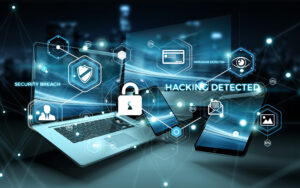
Understanding Cybersecurity Definitions
Information flows freely across the internet and digital technologies permeating every aspect of our lives. The need for robust cybersecurity has never been more critical. From personal data and financial information to critical infrastructure and national security, the digital realm is rife with threats that can have far-reaching consequences. we explore the fundamentals of understanding cybersecurity, its significance, and how it plays a pivotal role in safeguarding our digital world.
Cybersecurity is the practice of protecting computer systems, networks, and digital data from theft, damage, or unauthorized access. It encompasses a wide range of technologies, processes, and practices designed to defend against cyberattacks and ensure the confidentiality, integrity, and availability of digital assets.
At its core, cybersecurity is about guarding against threats in the digital space, just as physical security safeguards us in the physical world. Cyber threats can take various forms, such as viruses, malware, ransomware, phishing attacks, and even state-sponsored cyber espionage. Effective cybersecurity measures are essential to mitigate these risks.
The Pillars of Cybersecurity
To understand cybersecurity fully, it’s essential to break it down into its key pillars:
- Confidentiality: This pillar ensures that sensitive data remains private and accessible only to those with authorized access. Encryption techniques, access controls, and data classification are vital components of maintaining confidentiality.
- Integrity: Integrity ensures that data remains unaltered and trustworthy. Cybersecurity measures in this category include data validation, checksums, and digital signatures.
- Availability: This pillar focuses on ensuring that systems and data are available when needed. This includes measures to prevent and recover from hardware failures, DDoS attacks, and other disruptions.
- Authentication and Authorization: These are the gatekeepers of cybersecurity. Authentication verifies the identity of users or systems, while authorization defines what actions they are allowed to perform. Strong passwords, multi-factor authentication (MFA), and role-based access control fall under this category.
- Security Education and Training: Human error remains one of the leading causes of cybersecurity breaches. Proper training and awareness programs for employees and users are crucial to bolstering overall cybersecurity.
The Cybersecurity Landscape
Cyber threats continue to evolve rapidly, making it essential for cybersecurity professionals to stay vigilant and adaptive. Some of the major threats and trends in the cybersecurity landscape include:
- Advanced Persistent Threats (APTs): These are long-term, targeted cyberattacks often orchestrated by nation-states or well-funded organizations. APTs are characterized by their stealth and sophistication.
- Ransomware: Ransomware attacks involve encrypting a victim’s data and demanding a ransom for its release. This type of attack has gained notoriety in recent years due to high-profile incidents.
- IoT Vulnerabilities: As the Internet of Things (IoT) expands, so do the attack surfaces. Inadequately secured IoT devices can be entry points for cybercriminals.
- Cloud Security: The migration of data and applications to the cloud has opened up new security challenges. Proper configuration and access controls are crucial in the cloud environment.
Cybersecurity is not an option; it’s a necessity. The consequences of cyberattacks can be devastating, affecting individuals, businesses, and nations alike. By understanding the fundamentals of cybersecurity and staying informed about emerging threats and best practices, we can all contribute to a safer digital environment. Whether you’re a cybersecurity professional, a business owner, or an everyday internet user, your role in cybersecurity is vital. At Crossaction we can defend the digital frontier and ensure the security and resilience of our interconnected world.
